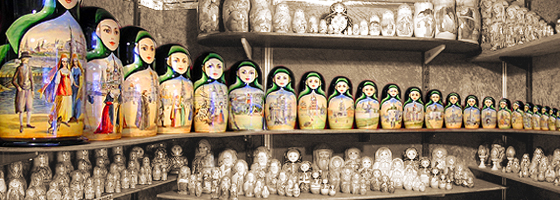Russian and other languages
The most common language in Russia is the Russian language. However, the number of speakers of eight more languages exceeds one million people each. Republics as parts of the Russian Federation can have their own state languages and, as a rule, they use this right.
Despite the efforts to preserve and develop local languages, there is still a trend for a linguistic shift, when in fact the native language of non-Russian citizens is Russian, while a superficial knowledge of the mother language (the language of one’s ethnic group) becomes nothing more than a marker of ethnicity.
Russian literature
Russian literature reflected not only aesthetic, moral and spiritual values and ideas. According to leading Russian thinkers, literature has also become the philosophy of Russia.
Until the 18th century, secular literature in Russia practically did not exist. There are several monuments of ancient Russian literature of religious or chronicle character: The Tale of Bygone Years, The Tale of Igor’s Campaign, The Prayer of Daniel the Exile, The Life of Alexander Nevsky. Folk art of that period is represented by fairy tales.
In the 18th century, a lot of secular writers and poets appeared in Russia: poets Vasily Trediakovsky, Antioch Cantemir, Gabriel Derzhavin, Mikhail Lomonosov; writers Nikolai Karamzin, Alexander Radishchev; playwrights Alexander Sumarokov and Denis Fonvizin.
The most famous poets of Russia are Alexander Pushkin, Mikhail Lermontov, Aleksandr Blok, Sergey Yesenin, Anna Akhmatova, Vladimir Mayakovsky, and many others.
The most famous writers of Russia are Fedor Dostoevsky, Leo Tolstoy, Ivan Bunin, Vladimir Nabokov, Ivan Turgenev, Anton Chekhov, and many others.
Russian painting
The first realistic portraits appear in Russia in the 17th century. In the middle - the end of the 18th century, such painters as Levitsky and Borovikovsky appeared in Russia. Outstanding artists of the first half of the 19th century: Kiprensky, Bryullov, Ivanov.
In the second half of the 19th century, the creative association of Russian artists “Association of Traveling Art Exhibitions” (“Peredvizhniki”) was founded, which included such great artists as Vasnetsov, Kramskoy, Shishkin, Kuindzhi, Surikov, Repin, Savrasov.
At the turn of the 19th-20th centuries, the association “World of Art” operated. Its members or artists close to the movement were Mikhail Vrubel, Kuzma Petrov-Vodkin, Nikolai Roerich, Isaak Levitan.
In the late 19th - early 20th century, Russia became one of the centers of avant-garde art: Vasily Kandinsky, Kazimir Malevich, Marc Chagall, Pavel Filonov.
Today, there are a lot of art museums and galleries in Russia. The most famous are the State Tretyakov Gallery in Moscow, the State Hermitage and the Russian Museum in St. Petersburg.
Other features of Russian culture
Russian classical music is known for the heritage of such great composers as Pyotr Tchaikovsky, Mikhail Glinka, Rimsky-Korsakov, Nikolai Andreevich, the commonwealth of the composers “The Mighty Bunch”, Sergei Rachmaninov, Igor Stravinsky. The most known Soviet composers are Sergei Prokofiev, Dmitri Shostakovich, Aram Khachaturian, Alfred Schnittke.
Russian theater art is one of the most promising in the world. In Russia, there are theaters with world fame, such as the Mariinsky Theater, the Bolshoi and Maly theaters.
In Russia, circus art is developed and popular. Among the famous circus performers are clowns Yuri Nikulin, Oleg Popov; illusionists Emil Kio and Igor Kio, trainers Vladimir Durov, brothers Edgard and Askold Zapashnye.
Movies produced in Russia and the predecessor countries are laureates of major international film festivals such as Berlin, Cannes, Venice, Moscow.
Soviet animation is known all over the world. At the most famous studios of the USSR and Russia (Soyuzmultfilm, Tsentrnauchfilm, Kievnauchfilm) thousands of cartoons were filmed. In 2003, in Tokyo, the cartoon “Hedgehog in the Fog” by Yuri Norshtein was recognized as the best cartoon of all time.
We should also mention such a symbol of Russian culture as “matryoshka” - a Russian wooden toy in the form of a painted doll, inside which there are similar dolls of smaller size.
Russian cuisine
The cuisine of Russia, like the culture of Russia, is a two-part entity. The first and most significant part of it - Russian cuisine, based on the Slavic traditions, as well as traditions borrowed from other nations that eventually joined the Russian state.
The second part of the cuisine of Russia refers to the national traditions of peoples and nationalities living in the country. The cuisine of each people has its own unique dishes and methods of their preparation, based on local products and made with the help of original kitchen utensils.
The most famous dishes of the cuisine of Russia are borscht, vinaigrette, pies, pancakes, cabbage soup, kvas, mors, and others.


